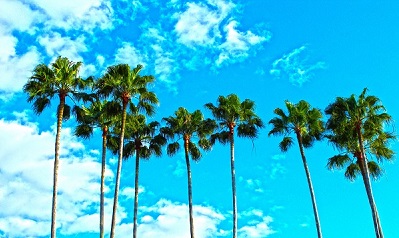PALMS
::
TREES
::
TROPICALS
::
SHRUBS
::
GROUNDCOVERS
::
ANNUALS
::
PERENNIALS
::
GRASSES
::
VINES
::
WATER PLANTS
::
BROMELIADS
::
SUCCULENTS
::
BUTTERFLY PLANTS
|

|
P A L M T R E E S T R E E S
 Palms are the epitomy of the tropics. Always lending an air of oases, beaches and jungles to any landscape, palms can never be overused. Unfortunately, out of the 3000 species of palms worldwide, only a handful are available for Florida Landscapes. Even worse, some of the more beautiful ones aren't used in Central Florida because of biased traditional fears of cold sensitivity. Most times,a southern exposure or a body of water is all it takes. We try to introduce these into our palette.
Palms are the epitomy of the tropics. Always lending an air of oases, beaches and jungles to any landscape, palms can never be overused. Unfortunately, out of the 3000 species of palms worldwide, only a handful are available for Florida Landscapes. Even worse, some of the more beautiful ones aren't used in Central Florida because of biased traditional fears of cold sensitivity. Most times,a southern exposure or a body of water is all it takes. We try to introduce these into our palette.
 Palms are among the easiest plants to grow, many growers recommend just popping them into the ground, no soil amendments needed. All palms, including desert natives, respond to basic fertilization and water, water, water. It's simple: more water, more growth!
Since most palms are considerably slow-growing when young, it's best to purchase them closest to the size you are aiming for. Most palms look excellent planted in groups of three or five, at varying heights, but also singly, as long they are not to far from contrasting foiliage. A palm tree surrounded by vast space always looks lonely.
Palms are among the easiest plants to grow, many growers recommend just popping them into the ground, no soil amendments needed. All palms, including desert natives, respond to basic fertilization and water, water, water. It's simple: more water, more growth!
Since most palms are considerably slow-growing when young, it's best to purchase them closest to the size you are aiming for. Most palms look excellent planted in groups of three or five, at varying heights, but also singly, as long they are not to far from contrasting foiliage. A palm tree surrounded by vast space always looks lonely.
 A footnote: please don't butcher your palms! Only trim yellowing or brown leaves; remember that green leaves produce food for the plant. Overtrimming may look groomed to the layman, not only will you lose that lush tropical look, but your palm will suffer in health and robustness. As with most palms and other trees, the golden rule is: first year they sleep, second year they creep, third year they leap!
A footnote: please don't butcher your palms! Only trim yellowing or brown leaves; remember that green leaves produce food for the plant. Overtrimming may look groomed to the layman, not only will you lose that lush tropical look, but your palm will suffer in health and robustness. As with most palms and other trees, the golden rule is: first year they sleep, second year they creep, third year they leap!
|
PALMS
 What's property without a tree? A big hot mess. Trees provide oxygen and shade, but you already know that. A canopy can provide an almost ten degree difference, cooler in the summer, warmer in the winter and not coincidentally, greatly increase your property value.
What's property without a tree? A big hot mess. Trees provide oxygen and shade, but you already know that. A canopy can provide an almost ten degree difference, cooler in the summer, warmer in the winter and not coincidentally, greatly increase your property value.
|
EUROPEAN FAN PALM
Chamaerops humilis
|
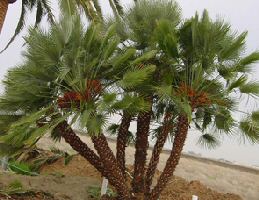
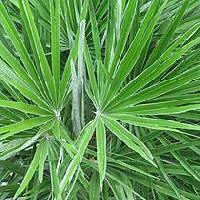
|
 Hailing from southern Europe, these palms would simply smile at any record cold Florida could experience. This clustering palm sports a human scale.
Hailing from southern Europe, these palms would simply smile at any record cold Florida could experience. This clustering palm sports a human scale.
|
|
BISMARKIA
Bismarckia nobilis
|
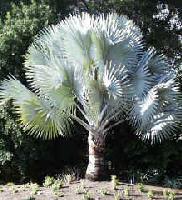
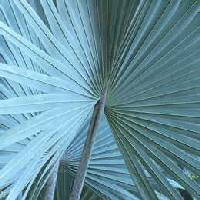
|
 This palm cannot be ignored. The leaf crown can span twenty feet. Add the striking blue, sliver to almost pure white color, and you have a beauty that demands attention. Bizzies (as they are affectionally known) were only found in the largest botanical gardens a few decades ago, now they are available to most. Native to Madagascar, they thrive on Florida's heat and light.
This palm cannot be ignored. The leaf crown can span twenty feet. Add the striking blue, sliver to almost pure white color, and you have a beauty that demands attention. Bizzies (as they are affectionally known) were only found in the largest botanical gardens a few decades ago, now they are available to most. Native to Madagascar, they thrive on Florida's heat and light.
 Bismarckias come in two color forms: Green and the popular Silver. Try to avoid the Green forms, as a rule; the less silver color, the less cold-hardy. Young Silver plants are recognised by a purple coloration. The more purple when young, the more the adults will become silver. Although able to grow in part sun, planting in full sun will assure the best coloration and health.
Bismarckias come in two color forms: Green and the popular Silver. Try to avoid the Green forms, as a rule; the less silver color, the less cold-hardy. Young Silver plants are recognised by a purple coloration. The more purple when young, the more the adults will become silver. Although able to grow in part sun, planting in full sun will assure the best coloration and health.
 Of course no plant is perfect; Bismarkias' Achilles Heel is its refusal to be transplanted. The only way to successfully plant this palm in the ground is to only use only potted specimens, carefully slitting the pot away from the rootball. In fact, try not to come in contact with the roots at all! Always use plants in containers, leave planting bare root trees to the professionals.
Of course no plant is perfect; Bismarkias' Achilles Heel is its refusal to be transplanted. The only way to successfully plant this palm in the ground is to only use only potted specimens, carefully slitting the pot away from the rootball. In fact, try not to come in contact with the roots at all! Always use plants in containers, leave planting bare root trees to the professionals.
|
|
QUEEN PALM
Syragus romanzoffianum
|
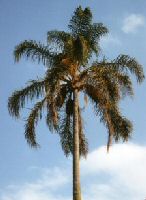
|
 The fast growth, cold hardiness, availability and affordabilty of these plants make them the bread-n-butter of ornamental palms in Florida. Their long, deep green arching feather-like leaves provide a tropical appearing canopy wherever they're used. Beware; if you can't provide regular fertilizer and moisture, avoid growing these babies, unless your goal is a yellow sickly palm. Like people, the care they receive remarkably mirrors their health and appearance.
The fast growth, cold hardiness, availability and affordabilty of these plants make them the bread-n-butter of ornamental palms in Florida. Their long, deep green arching feather-like leaves provide a tropical appearing canopy wherever they're used. Beware; if you can't provide regular fertilizer and moisture, avoid growing these babies, unless your goal is a yellow sickly palm. Like people, the care they receive remarkably mirrors their health and appearance.
|
|
RADICALIS PALM
Chamadorea radicalis
|
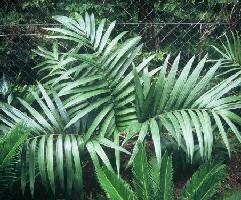
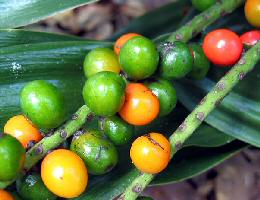
|
 We are beyond shocked that this great palm isn't in every Central Florida yard. Only a few feet high and a shade lover, there is always room for it. Its remarkably tropical appearence gives no clue that it's hardy to 18 degrees! Once established, this Mexican palm is decorated year-round with eye-catching red and orange fruits. Grow one. No, grow five!
We are beyond shocked that this great palm isn't in every Central Florida yard. Only a few feet high and a shade lover, there is always room for it. Its remarkably tropical appearence gives no clue that it's hardy to 18 degrees! Once established, this Mexican palm is decorated year-round with eye-catching red and orange fruits. Grow one. No, grow five!
|
|
DWARF DATE PALM
Phoenix roebelinii
|
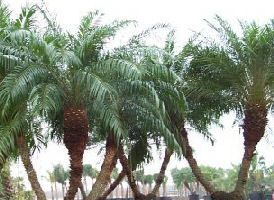
|
 As common as they are in our area mature specimens are rare to locate.
As common as they are in our area mature specimens are rare to locate.
 The delicate fern-like appearance of these palms belie their toughness. You can throw them in the back of your truck and speed over distances, but the leaves will remain undamaged. Which means: they are hurricane-proof, a major plus for Florida. As with most palms, they love water.
The delicate fern-like appearance of these palms belie their toughness. You can throw them in the back of your truck and speed over distances, but the leaves will remain undamaged. Which means: they are hurricane-proof, a major plus for Florida. As with most palms, they love water.
|
|
FLORIDA THATCH PALM
Thrinax morrisii
|
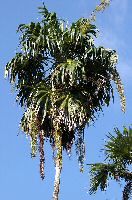
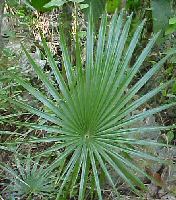
|
 This medium sized palm is native to South Florida, but has proven to be hardy in Central Florida. It's perfectly shaped leaves rustle in the slightest winds and thrives in almost any condition. Slow growing when young, with age it forms a thin trunk.
This medium sized palm is native to South Florida, but has proven to be hardy in Central Florida. It's perfectly shaped leaves rustle in the slightest winds and thrives in almost any condition. Slow growing when young, with age it forms a thin trunk.
|
|
PINDO PALM
Butia capitata
|
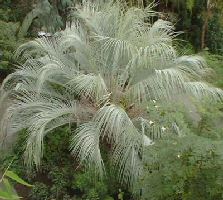
|
 Also known as the Jelly Palm because of the edible fruits, high in vitamin C,
The large leaves arching from the stout trunt imparts an almost proctective feel.
The foilage ranges from yellow-green to silver-blue, the latter being more desirable. Pindos should always be used as single specimens, groupings have a tendency to look disordely, because of their obvious individual differences. When you host one of these grand palms, you provide beauty far into the future; in their native haunts they may live for thousands of years. As with all silver-leafed palms, plant in full sun for best color.
Also known as the Jelly Palm because of the edible fruits, high in vitamin C,
The large leaves arching from the stout trunt imparts an almost proctective feel.
The foilage ranges from yellow-green to silver-blue, the latter being more desirable. Pindos should always be used as single specimens, groupings have a tendency to look disordely, because of their obvious individual differences. When you host one of these grand palms, you provide beauty far into the future; in their native haunts they may live for thousands of years. As with all silver-leafed palms, plant in full sun for best color.
|
|
DATE PALM
Phoenix dactylifera
|
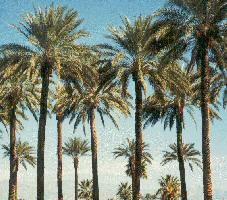
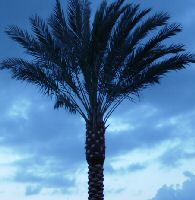
|
 Dates have been cultivated since history for their fruits, but of course we plant them for their beauty. Date Palms
Dates have been cultivated since history for their fruits, but of course we plant them for their beauty. Date Palms
Newer varieties such as 'Medjool' are proven to perform well in Florida'a humid climate.
|
|
ROYAL
Roystonea elata, Roystonea regia
|
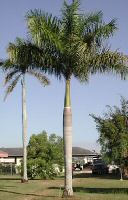
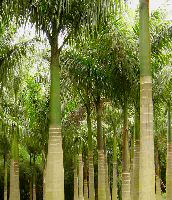
|
 Royal Palms dominate South Florida with their unmistakable regal air, but they are forsaken here in Central Florida for fear of frost. We would like to change that. The secret to hardy Royals in our area is to install plants which have at least a foot of trunk; after this stage they ususally sail through frost unscathed. The huge dimensions, concrete smooth trunk and livid green crownshaft makes it worth any discriminatory palnt selection.
Royal Palms dominate South Florida with their unmistakable regal air, but they are forsaken here in Central Florida for fear of frost. We would like to change that. The secret to hardy Royals in our area is to install plants which have at least a foot of trunk; after this stage they ususally sail through frost unscathed. The huge dimensions, concrete smooth trunk and livid green crownshaft makes it worth any discriminatory palnt selection.
|
|
DIOON
Dioon edule
|
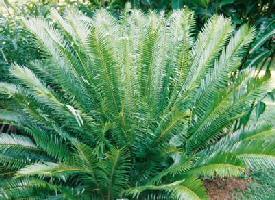
|
 Dioon is a not a Palm, only Palm-like. We include this Mexican Cycad as a replacement for King and Queen Sagos, because of the often fatal imported Asian Cycad Scale, currently wreaking havoc on Central Florida Sagos. Dioon is resistant to this pest and more cold hardier than Sagos. It also features a finer, yet stiffer foilage, which is seldom marred. Some individual plants display very attractive lavender new leaves. A beauty.
Dioon is a not a Palm, only Palm-like. We include this Mexican Cycad as a replacement for King and Queen Sagos, because of the often fatal imported Asian Cycad Scale, currently wreaking havoc on Central Florida Sagos. Dioon is resistant to this pest and more cold hardier than Sagos. It also features a finer, yet stiffer foilage, which is seldom marred. Some individual plants display very attractive lavender new leaves. A beauty.
|
|
LADY PALM
Rhapis excelsa
|
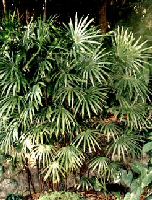
|
 Lady Palms, from Southern China, should have a place in every shady Florida garden. Once established, it can endure drought, freezing cold and is virtually pest-free. Bamboo-like in appearance, it's charm is unequaled. Great for under trees and northern exposure. It is a slow but sure grower, spreading cane by cane, but before you know it, you'll have a thick screen of beautiful deep glossy green foilage. Provide shade and protection from winds, just add water! Always imparts a calming feel.
Lady Palms, from Southern China, should have a place in every shady Florida garden. Once established, it can endure drought, freezing cold and is virtually pest-free. Bamboo-like in appearance, it's charm is unequaled. Great for under trees and northern exposure. It is a slow but sure grower, spreading cane by cane, but before you know it, you'll have a thick screen of beautiful deep glossy green foilage. Provide shade and protection from winds, just add water! Always imparts a calming feel.
|
|
WEEPING CHINESE FAN PALM
Livistona chinensis
|
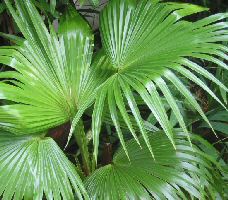
|
 Another shade lover from Southern China, this palm is cold hardy with a moderate growth rate. Its weeping form gives it a romantic appearance.
Another shade lover from Southern China, this palm is cold hardy with a moderate growth rate. Its weeping form gives it a romantic appearance.
|
|
FOXTAIL PALM
Wodeytia bifurcata
|
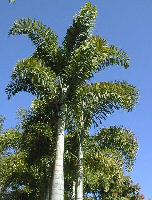
|

 Unknown to civilization until 1986, theses rare Australian palms have skyrocketed to popularity and now are available in all subtropical areas around the world. The reasons include fast growth, easy care, drought tolerance, and of course beauty! They love Florida's sandy soil. During severe cold they may exhibit minor leaf-spotting, but this is not nocitable, especially as soon as they quicky produce new leaves with the appoach of the growing season.
Unknown to civilization until 1986, theses rare Australian palms have skyrocketed to popularity and now are available in all subtropical areas around the world. The reasons include fast growth, easy care, drought tolerance, and of course beauty! They love Florida's sandy soil. During severe cold they may exhibit minor leaf-spotting, but this is not nocitable, especially as soon as they quicky produce new leaves with the appoach of the growing season.
|
|
MONTGOMERY PALM
Veitchia arecina
|

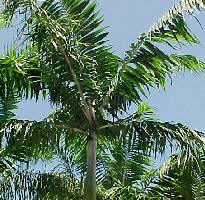
|
 While being a truly tropical palm from the South Pacific, mature specimens have been tried and tested in many sheltered Central Florida sites. A palm seemingly made of more air than foilage, though somewhat common in South Florida, it is guaranteed to turn heads in Central Florida.
While being a truly tropical palm from the South Pacific, mature specimens have been tried and tested in many sheltered Central Florida sites. A palm seemingly made of more air than foilage, though somewhat common in South Florida, it is guaranteed to turn heads in Central Florida.
|
|


